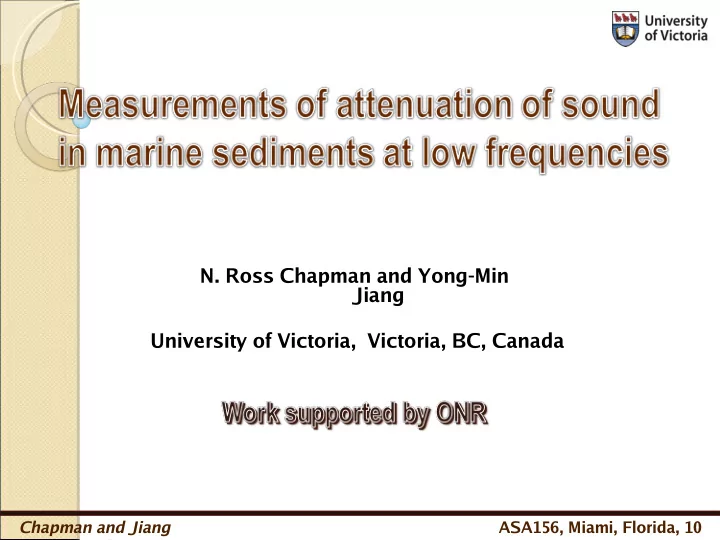

N. Ross Chapman and Yong-Min Jiang University of Victoria, Victoria, BC, Canada Chapman and Jiang ASA156, Miami, Florida, 10 – 14 November 2008
Estimate sediment attenuation from single bounce reflections from sea bottom and sub- bottom • Experimental site & set up • The method of estimating sediment attenuation • Data processing • Supporting parameters in estimating attenuation • Discussion of the results • Conclusions and future works Chapman and Jiang ASA156, Miami, Florida, 10 – 14 November 2008
• Varying source depth + VLA to ensure angular coverage Moray site • Water depth ~ 79m • Range ~ 230m • Source depth: 15-65m in 10m steps • Receiver depth: 14.25-70.5m @ 3.75m Chapman and Jiang ASA156, Miami, Florida, 10 – 14 November 2008
p V p T T V ( ) − α + = ( ) - + - · + 0 r 1 r = ( r r ) ( f ) ( r r ) bott 0 ws sw s a a p e , p e e w 2 w 3 4 s 5 6 + b sb + + + r r r r r r 1 2 3 4 5 6 • = + + • α ' 20 log( p / p ) b ( r r ) ( f ) Estimated at different frequencies b sb 5 6 s by band pass filtering the signal From data Constant under frequency independent assumption and ignori the attenuation in the water Chapman and Jiang ASA156, Miami, Florida, 10 – 14 November 2008
Signal frequency band Sea bottom reflection Sub- bottom reflection 1500~4500Hz Chapman and Jiang ASA156, Miami, Florida, 10 – 14 November 2008
fo=1750 Hz fo=2550 Hz Signals after band passing fo=1750-4150Hz, 200Hz separation Chapman and Jiang ASA156, Miami, Florida, 10 – 14 November 2008
Difference of bot. & sub-bot., 06243145200, iphone:11, zs=45.0m, zr=33.00m 35 30 Amplitude (dB) 25 20 15 10 5 1000 2000 3000 4000 5000 Frequency (Hz) The slope = (r 5 + r 6 )* α ’ s , where (r 5 + r 6 ) is the path length in the sediment, α ’ s is in dB/m.kHz Need to be inverted α ( λ) = α ’ s *c s /1000 c s is the sound speed in the sediment, α (λ) is in dB/ λ Chapman and Jiang ASA156, Miami, Florida, 10 – 14 November 2008
• Invert for water depth, range, source depth and array tilt fro SD=65m data; • Invert for water column SSP for desired source depth data; • Invert for sediment sound speed and layer thickness by us inverted geometric parameters and SSP in the water; optimal inversion approach use of travel time information forward model is based on ray theory Chapman and Jiang ASA156, Miami, Florida, 10 – 14 November 2008
iphone:13, zs=35.0m, zr=26.00m, a=8.72024 35 30 25 Amplitude ratio(dB) Receiver depth = 26m 20 15 10 iphone:12, zs=35.0m, zr=29.75m, a=8.30714 35 5 1 1.5 2 2.5 3 3.5 4 4.5 5 Frequency (Hz) 30 25 Amplitude ratio(dB) Receiver depth = 29.75m 20 15 10 5 1 1.5 2 2.5 3 3.5 4 4.5 5 Frequency (Hz) Chapman and Jiang ASA156, Miami, Florida, 10 – 14 November 2008
Ray prediction from the inversion 0 10 20 22.25m 26.00m 30 29.75m Source=35m Depth (m) 33.50m 37.25m 40 41.00m 44.75m 48.50m 50 52.25m 60 70 Sea bottom 80 90 Sub-bottom 100 0 50 100 150 200 250 Range (m) Sediment Sound speed: 1602.2 m Sediment layer thickness: 20.8m RD: 26.00 m Path length in the sediment: 95.1 m RD: 29.75 m Path length in the sediment: 97.8 m Chapman and Jiang ASA156, Miami, Florida, 10 – 14 November 2008
Source depth (m) 35 45 Receiver depth (m) 26.0 29.75 26.0 33.5 Attenuation 0.092 0.085 0.101 0.088 (dB/m•kHz) Attenuation (dB/ λ) 0.15 0.14 0.16 0.14 • The signal fluctuation caused by the variable water environment and the interference of the reflections of fine structure in the sediment • The errors of sediment sound speed and layer thickness estimates introduced by travel time picking Chapman and Jiang ASA156, Miami, Florida, 10 – 14 November 2008
• The marine sediment sound attenuation at low frequency can be estimated from single bounce sub-bottom reflections • The estimated attenuation values are consistent with previous result done in the vicinity by use of transmission loss inversion (Carey) • The method could be used for future experimental design • The uncertainty analysis of the estimate • Compare with the circle data at ‘Moray’ site and SWAMI 32 site • Office of Naval Research: for sponsoring the research • Drs. William Hodgkiss and Peter Gerstoft from MPL: acoustic data Chapman and Jiang ASA156, Miami, Florida, 10 – 14 November 2008
iphone:13, zs=45.0m, zr=26.00m, a=11.28274 35 30 25 Amplitude ratio(dB) Receiver depth = 26.0 m 20 15 10 iphone:11, zs=45.0m, zr=33.50m, a=10.52286 35 5 1 1.5 2 2.5 3 3.5 4 4.5 5 Frequency (Hz) 30 25 Amplitude ratio(dB) Receiver depth = 33.5 m 20 15 10 5 1 1.5 2 2.5 3 3.5 4 4.5 5 Frequency (Hz) Chapman and Jiang ASA156, Miami, Florida, 10 – 14 November 2008
Ray prediction from the inversion 0 10 20 22.25m 26.00m 29.75m 30 33.50m Depth (m) 37.25m 40 41.00m Source=45m 44.75m 48.50m 50 60 70 Sea bottom 80 90 100 Sub-bottom 0 50 100 150 200 250 Range (m) Sediment Sound speed: 1618.2 m Sediment layer thickness: 22.2 m RD: 26.00 m Path length in the sediment: 112.1 m RD: 33.50 m Path length in the sediment: 119.1 m Chapman and Jiang ASA156, Miami, Florida, 10 – 14 November 2008
Recommend
More recommend